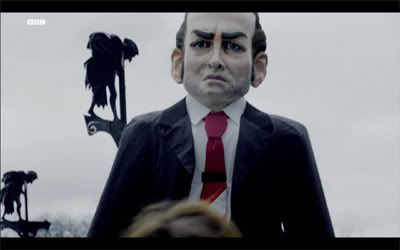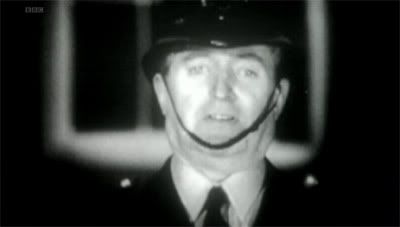'Thus we reach the end, the beginning and the end.'
The ending of Ashes to Ashes depicted the arrival of a new police officer from modern times. “Where’s my office?” he bellows, staring wildly around the room as the inhabitants of CID cast him sideways glances. The last scene is one of arrival, the whole cycle starting again. It is clear there won’t be a third series, no “Jump They Say.” Another series would be superfluous, for by this point the nature of Gene Hunt’s world is clear. No more explanations are necessary.
I thought it was appropriate to begin this review of the final episode of Ashes to Ashes with a quote from a song from the eighties. In this case, the song is “The Beginning and the End” by OMD. As much as it has been weird, unorthodox and spiritual, Ashes has been a nostalgia trip.
Many casual viewers watch the show for the fashions and the soundtrack, and the bra-strap revealing tops and Phil Collins hits remain intact despite the building madness of the narrative.
I loved the songs and the costumes, but I also invested time, effort and thought in considering the mysteries Ashes to Ashes and Life on Mars presented. What were the strange dreams that afflicted DIs Sam Tyler and Alex Drake? Why would coma-situations send them back to periods they know from their childhoods? Who was Gene Hunt?
This episode offered answers to those questions and the multitude of others that have been considered by fans throughout the series. It begins with a dream where Alex sees her daughter Molly for the first time in the series. She and Hunt appear as grotesque caricatures in an “It’s a Knockout” sequence where Alex navigates a series of obstacles, only to fall and clamber out of her frozen faced, bloated shell. The dream ends as Hunt looms over Alex, a frightening, heightened presence. Molly wears a scarf in this scene that is identical to one the sinister DCI Keats gives to Alex at the end of the episode. Keats gives this to Alex in an effort to tempt her to him, indulging her newly-returned desire to return to Molly. This temptation - like the dream that opens the episode - is baseless. Alex is dead and will never see her daughter again.
Alex isn’t alone. The friends she has accumulated in the Gene-verse discover exactly what they have been trying to forget in personalized Betamax tapes. Ray hanged himself in despair. Chris was shot after being ordered to run forward by the blow of a whistle. Shaz was stabbed with a screwdriver. Their deaths – and more pertinently, these characters’ repression of them – have been referenced throughout this series. In episode two, Shaz flung a screwdriver away from her with a scream. Episode three followed Ray as he was haunted by his failure to live up to his father’s expectations of him. The penultimate episode had Chris getting jittery at the echo of the police whistle that signalled his death.
Their world literally unravels around them in the wake of their realizations of their deaths. The harsh, untimely deaths they were initially able to forget in Gene’s world are thrust into their faces, and Keats crows in delight as he capitalizes on their disillusionment. He transforms from a staid, petty pen-pusher into a hysterical, cackling madman, jumping on a desk and whooping in triumph as the chequered roof of CID is replaced by a vast, starry abyss.
If Keat’s malevolence wasn’t clear from his actions at the end of the sixth episode (where he goggled, gleeful, as Viv died in his arms), it was made obvious in the scene where he beat a deflated Gene to a bloody pulp. During the beating, the hardened, pock-faced Gene Hunt so familiar from five television series is replaced by his past self. A young, smooth-skinned PC is shown instead of the gruff, middle-aged cynic the viewer has become familiar with, for they are the same person. The older Gene Hunt is the product of a murdered PC’s fantasy of a DCI, an imaginary figure influenced by the morality of Hollywood westerns and the self-righteous, do-goodery of 1950s police-procedurals such as Dixon of Dock Green.
I teared up at the end of the episode, for after the credits a prediction I made last week came true. One of the show’s creator’s indicated that the series would end in black and white and the last shot would show the word ‘Police.’ The final seconds of Ashes to Ashes feature Jack Warner as PC George Dixon, smiling reassuringly at the viewer before the camera tilts up shakily to display the proverbial blue lamp.
I think I cried both from a sense of egotistical pride and the knowledge that it’s all come to an end. I have invested three years in this series, theorizing about its clues and analyzing its characters. I got 99% of it wrong, but the 1% I got right made all that effort feel worthwhile.
Ashes to Ashes ends with a sense of harmony. The characters we have come to know and care for – Alex, Ray, Chris and Shaz – receive the reward of progress, for none of them are condemned to remain in Gene’s petrified fantasy world, an environment that can only help them to a certain point before it must be left behind. Gene himself remains, and is – as the final song of the series proclaims – a “hero” for he continues to help others even after he realizes that he, as the audience knows him, is a fantasy.
This series has proven what television is capable of. Ashes was a slow-burn mystery, one that truly engaged its audience. We won't see anything like it again for a long, long time, and when we do it will truly be worth savouring.







